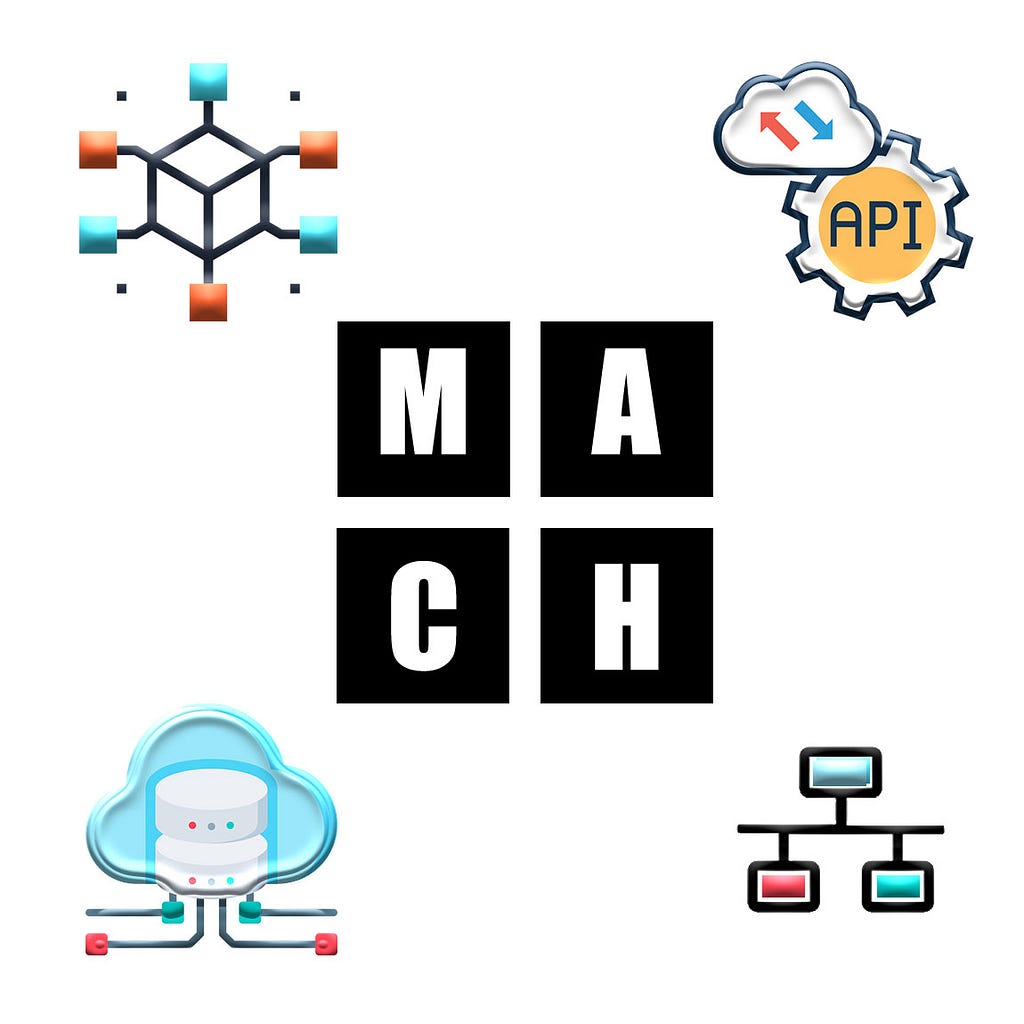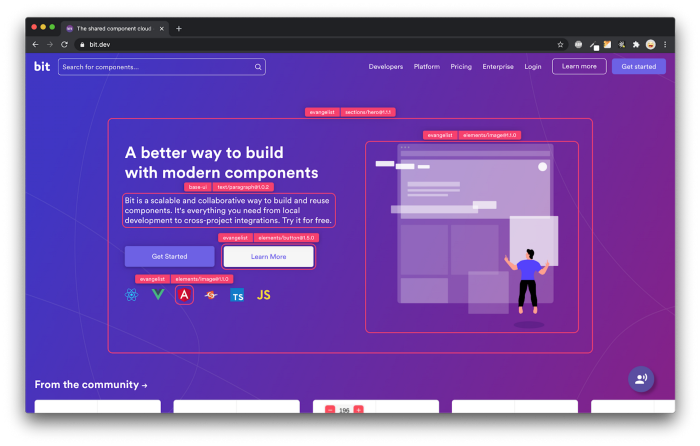This content originally appeared on Bits and Pieces - Medium and was authored by Ankur Patel

Microservices-based, API-first, Cloud-native, and Headless (MACH) is a modern architectural pattern that is gaining popularity among software developers. It is a combination of four different architectural concepts that are designed to work together to create highly scalable, flexible, and performant systems.
Microservices-based architecture refers to the practice of building an application as a collection of small, independent services that communicate with each other through APIs. This approach allows for more efficient development and deployment, as well as better scalability and fault tolerance. By breaking down a large monolithic application into smaller, independent services, it becomes easier to understand, test, and maintain.
API-first architecture refers to the practice of designing and building APIs before the actual application. This approach allows for better decoupling of the front-end and back-end, as well as easier integration with other systems. API-first also enables a headless CMS, which is an architecture where the front-end and back-end are completely decoupled, and the back-end is only used to deliver the content via API.
Cloud-native architecture refers to the practice of building and deploying applications in the cloud. This approach allows for better scalability, cost-efficiency, and flexibility. Cloud-native applications are designed to take advantage of the cloud’s resources, such as automatic scaling, load balancing, and self-healing.
Headless architecture refers to the practice of building a backend only, with no frontend. This approach allows for better decoupling of the front-end and back-end, as well as easier integration with other systems. This architecture is typically used in conjunction with a headless CMS, where the front-end is built separately and the back-end is only used to deliver the content via API.
Example
An application built using MACH architecture is an e-commerce platform. The platform is broken down into several microservices, each responsible for a different aspect of the platform, such as product management, inventory management, and order management.
These microservices communicate with each other through APIs, which are designed and built using an API-first approach.
The platform is built using cloud-native technologies, such as Kubernetes and Docker, which allows for easy scaling and deployment.
Additionally, the platform has a headless architecture, which allows for easy integration with other systems, such as a mobile app or a voice-enabled device.
Component-Driven Microservices with NodeJS and Bit
Benefits
- Scalability: One of the main benefits of MACH architecture is scalability. By breaking down a large monolithic application into smaller, independent services, it becomes easier to scale each service separately as needed. This means that if one service becomes a bottleneck, it can be scaled independently of the other services, without affecting the overall performance of the application. This allows for better resource utilization and cost efficiency.
- Flexibility: MACH architecture allows for a high degree of flexibility by decoupling the front-end and back-end. This allows for easy integration with other systems and technologies. For example, a headless architecture allows for easy integration with a mobile app or a voice-enabled device. Additionally, the API-first approach allows for easy integration with other systems and services.
- Performance: Microservices can be deployed and scaled independently, which allows for better fault tolerance and improved performance. Each microservice can be designed and optimized for a specific task, which can lead to better performance overall. Additionally, cloud-native technologies such as Kubernetes and Docker allow for automatic scaling and self-healing, which can improve the overall performance of the application.
- Cost efficiency: Cloud-native technologies allow for cost-efficient deployment and scaling of the application. By using cloud services, it is possible to only pay for the resources that are used, and not have to invest in expensive hardware. Additionally, the use of containerization and orchestration can lead to more efficient resource utilization, which can further reduce costs.
- Reusability: Microservices can be reused across multiple applications, leading to greater development efficiency. By breaking down an application into smaller, independent services, it becomes possible to reuse these services in other applications, which can save development time and resources. This also allows for better maintainability and testability, as each service can be tested and updated independently of the others. Toolchains such as Bit provide a robust architecture and framework to be able to built reusable microservices quickly and efficiently.
Challenges & How to Overcome Them
Complexity
Managing and deploying a large number of microservices can be complex and difficult. It requires a good understanding of the application’s architecture and how the different services interact with each other. Additionally, managing the communication and data flow between the services can be challenging.
To overcome this challenge, it is important to have a clear understanding of the application’s architecture and to use tools such as Kubernetes to manage the deployment and scaling of the services.
Monitoring and debugging
It can be challenging to monitor and debug a system made up of many microservices. Since each service runs independently, it can be difficult to understand how the services are interacting with each other and how they are impacting the overall performance of the application.
To overcome this challenge, it is important to use monitoring and logging tools to track the performance of each service. Additionally, the use of distributed tracing tools and service meshes can provide more insights into inter-service communication.
Network Latency
Communication between microservices can introduce network latency, which can affect application performance.
To overcome this challenge, it is important to minimize the number of network calls and to use efficient communication protocols such as gRPC or HTTP/2. Additionally, it’s important to monitor and optimize the network communication between the services.
Security
Securely managing and communicating between multiple microservices can be a challenge. Each service runs independently, which means that each service must be secured separately. Additionally, secure communication between the services must be established.
To overcome this challenge, it is important to use security best practices such as encryption, authentication, and authorization for each service. Additionally, the use of service meshes can provide a central point of control for network-level security.
Testing
Testing an application made up of many microservices can be difficult and time-consuming.
To overcome this challenge, it is important to have a clear understanding of the application’s architecture and to test each service independently. Additionally, it is important to use automated testing tools to ensure that the services are working correctly and that the communication between the services is working as expected.
It’s worth noting that the benefits of MACH architecture often outweigh the challenges and with the right planning and approach, most of the challenges can be mitigated.
Conclusion
MACH architecture is a powerful architectural pattern that can be used to create highly scalable, flexible, and performant systems.
By combining the concepts of microservices, API-first, cloud-native, and headless architecture, it is possible to create applications that are easy to understand, test, and maintain, and can take advantage of the cloud’s resources for better scalability, cost-efficiency, and flexibility.
Build Microservices with reusable components

Bit’s open-source tool help 250,000+ devs to build apps with components.
Turn any UI, feature, or page into a reusable component — and share it across your applications. It’s easier to collaborate and build faster.
Split apps into components to make app development easier, and enjoy the best experience for the workflows you want:
→ Micro-Frontends
→ Design System
→ Code-Sharing and reuse
→ Monorepo
Learn more
- How We Build Micro Frontends
- How we Build a Component Design System
- Bit - Component driven development
- 5 Ways to Build a React Monorepo
- How to Create a Composable React App with Bit
MACH Architecture in Detail was originally published in Bits and Pieces on Medium, where people are continuing the conversation by highlighting and responding to this story.
This content originally appeared on Bits and Pieces - Medium and was authored by Ankur Patel
Ankur Patel | Sciencx (2023-02-21T11:33:47+00:00) MACH Architecture in Detail. Retrieved from https://www.scien.cx/2023/02/21/mach-architecture-in-detail/
Please log in to upload a file.
There are no updates yet.
Click the Upload button above to add an update.
